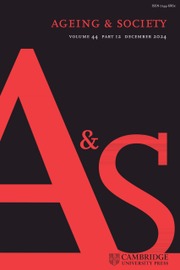Crossref Citations
This article has been cited by the following publications. This list is generated based on data provided by
Crossref.
Brandt, Martina
Deindl, Christian
and
Hank, Karsten
2011.
Tracing the Origins of Successful Aging: The Role of Childhood Conditions and Societal Context.
SSRN Electronic Journal,
McInnes, Lynn
2011.
Importance of Maintaining Mobility to Elderly Health.
Aging Health,
Vol. 7,
Issue. 2,
p.
165.
Hank, K.
2011.
How "Successful" Do Older Europeans Age? Findings From SHARE.
The Journals of Gerontology Series B: Psychological Sciences and Social Sciences,
Vol. 66B,
Issue. 2,
p.
230.
Brandt, Martina
Deindl, Christian
and
Hank, Karsten
2012.
Tracing the origins of successful aging: The role of childhood conditions and social inequality in explaining later life health.
Social Science & Medicine,
Vol. 74,
Issue. 9,
p.
1418.
Fagerström, Jessica
and
Aartsen, Marja
2013.
Successful Ageing and its Relationship to Contemporary Norms. A Critical Look at the Call to “Age Well”.
Recherches sociologiques et anthropologiques,
Vol. 44,
Issue. 1,
p.
51.
Cosco, Theodore D
Prina, A Matthew
Perales, Jaime
Stephan, Blossom C M
and
Brayne, Carol
2013.
Lay perspectives of successful ageing: a systematic review and meta-ethnography.
BMJ Open,
Vol. 3,
Issue. 6,
p.
e002710.
Thompson, Sue
2013.
Reciprocity and Dependency in Old Age.
p.
15.
Carmichael, Fiona
Hulme, Claire
and
Porcellato, Lorna
2013.
Older age and ill‐health: links to work and worklessness.
International Journal of Workplace Health Management,
Vol. 6,
Issue. 1,
p.
54.
Pearson, Elissa L.
Windsor, Tim D.
Crisp, Dimity A.
Butterworth, Peter
Pilkington, Pamela D.
and
Anstey, Kaarin J.
2013.
Normative data and longitudinal invariance of the Life Engagement Test (LET) in a community sample of older adults.
Quality of Life Research,
Vol. 22,
Issue. 2,
p.
327.
Péntek, Márta
Rojkovich, Bernadette
Czirják, László
Géher, Pál
Keszthelyi, Péter
Kovács, Attila
Kovács, László
Szabó, Zita
Szekanecz, Zoltán
Tamási, László
Tóth, Ágnes Edit
Ujfalussy, Ilona
Hevér, Noémi Vártokné
Strbák, Bálint
Baji, Petra
Brodszky, Valentin
and
Gulácsi, László
2014.
Acceptability of less than perfect health states in rheumatoid arthritis: the patients’ perspective.
The European Journal of Health Economics,
Vol. 15,
Issue. S1,
p.
73.
KIMKYOSEONG
and
Kim, Soo-Yeon
2014.
Multi-dimensional Measuring and Multi-level Analysis of Active Ageing in 16 OECD Countries.
Social Welfare Policy,
Vol. 41,
Issue. 1,
p.
1.
Cosco, Theodore D.
Prina, A. Matthew
Perales, Jaime
Stephan, Blossom C. M.
and
Brayne, Carol
2014.
Operational definitions of successful aging: a systematic review.
International Psychogeriatrics,
Vol. 26,
Issue. 3,
p.
373.
Khan, Abdul Rashid
and
Tahir, Ibrahim
2014.
Influence of Social Factors to the Quality of Life of the Elderly in Malaysia.
Open Medicine Journal,
Vol. 1,
Issue. 1,
p.
29.
Shen, Yuying
Yeatts, Dale E.
Cai, Tianji
Yang, Philip Q.
and
Cready, Cynthia M.
2014.
Social Capital and Self-Rated Health Among Middle-Aged and Older Adults in China.
Research on Aging,
Vol. 36,
Issue. 4,
p.
497.
Lamb, Sarah
2014.
Permanent personhood or meaningful decline? Toward a critical anthropology of successful aging.
Journal of Aging Studies,
Vol. 29,
Issue. ,
p.
41.
Hicks, Maxine M.
and
Conner, Norma E.
2014.
Resilient ageing: a concept analysis.
Journal of Advanced Nursing,
Vol. 70,
Issue. 4,
p.
744.
Rashid, Abdul
and
Tahir, Ibrahim
2015.
The Prevalence and Predictors of Severe Depression Among the Elderly in Malaysia.
Journal of Cross-Cultural Gerontology,
Vol. 30,
Issue. 1,
p.
69.
Aird, Rosemary L.
and
Buys, Laurie
2015.
Active Aging: Exploration into Self-Ratings of “Being Active,” Out-of-Home Physical Activity, and Participation among Older Australian Adults Living in Four Different Settings.
Journal of Aging Research,
Vol. 2015,
Issue. ,
p.
1.
Löckenhoff, Corinna E.
Lee, Diana S.
Buckner, Katherine M. L.
Moreira, Rashidat O.
Martinez, Stephanie J.
and
Sun, Mary Q.
2015.
Successful Aging.
p.
321.
Tobiasz-Adamczyk, Beata
2015.
Relation between medical sociology and sociology of ageing or later life. A new challenges, social expectations and dilemmas.
Anthropological Review,
Vol. 78,
Issue. 3,
p.
233.


